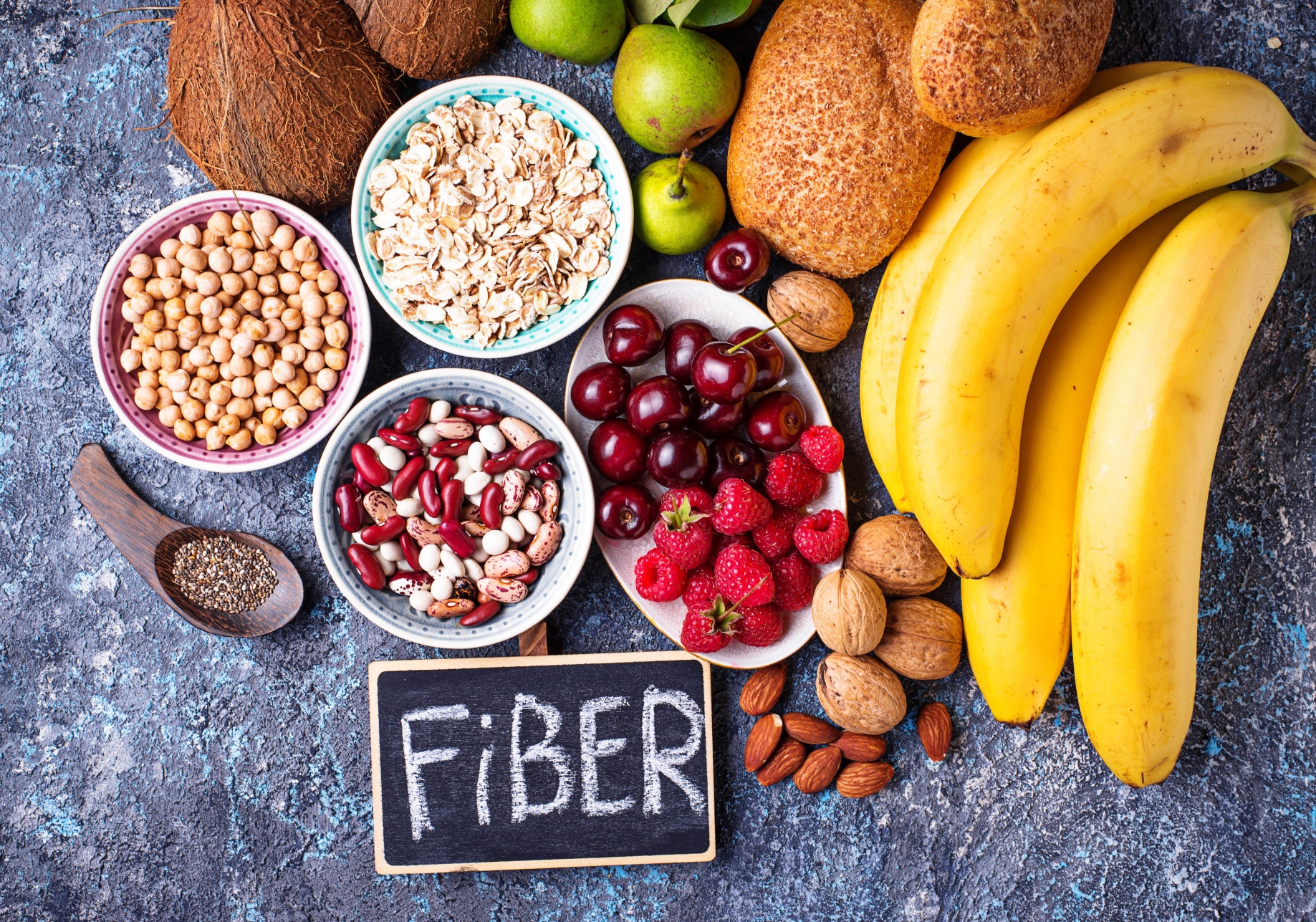While it’s unclear who first said, “You are what you eat,” whoever it was, they were really onto something! Your diet has the power to enhance your health and fitness or derail them completely. Therefore, what you eat really matters.
All of the food groups are important, and so, too, are vitamins and minerals. However, there is another substance your body needs in abundance – fiber. But how much do you need?
Use this calculator to determine your ideal fiber intake.
Fiber Calculator
Result:
Daily calorie intake: calculated Kcal
Recommended fiber per day: calculated g
The Importance of Dietary Fiber
Fiber, otherwise known as non-starch polysaccharide or NSP for short, is a type of carbohydrate. However, because it is so tough, fiber is essentially indigestible. As such, it passes through the human intestinal tract undigested, making it calorie-free.
There are two types of fiber – soluble and insoluble, and both are highly beneficial. In simple terms, soluble fiber essentially soaks up harmful substances, while insoluble fiber sweeps other harmful substances away. Both add bulk to your digestive waste, making it easier to excrete.
In addition, high-fiber foods are more filling, chewier, and take longer to eat than processed foods, making them helpful for weight management.
Level Up Your Fitness: Join our 💪 strong community in Fitness Volt Newsletter. Get daily inspiration, expert-backed workouts, nutrition tips, the latest in strength sports, and the support you need to reach your goals. Subscribe for free!
The benefits of fiber include (1):
- Easier weight loss
- Improved digestive system health
- Healthier gut bacteria
- Increased satiety
- Lower blood glucose
- Reduced blood pressure
- Lower cancer risk
- Reduced cholesterol and better blood lipid profile
- Lower risk of constipation
- Lower risk of heart disease
- Better nutrient absorption
Unfortunately, the Standard American Diet, known appropriately as SAD, is very low in fiber. That’s because fiber is typically removed when foods are processed. For example, skins are removed from fruits and vegetables, and grains lose their outer husks.
Consequently, according to a 2001 article published by The American Society for Nutrition, less than 10% of adults consume adequate fiber (2).
But how much fiber do you need to be healthy?
The typical recommendation for adults is around 28-35 grams per day. However, this fails to account for body weight, gender, or age, all of which affect your fiber requirements. As a result, for some people, 28-35 grams of fiber will be too low, while for others, it could be too high.
Our fiber calculator provides personalized fiber intake recommendations based on your individual needs. This takes the guesswork out of determining how much fiber you should eat.
How to Use the Fiber Calculator
Our fiber calculator is very easy to use. Just follow these step-by-step instructions to obtain your ideal daily fiber intake.
- Choose your preferred units, selecting either imperial (pounds, feet, and inches) or metric (kilograms, meters, and centimeters).
- Select your gender, choosing between male and female.
- Input your age in years.
- Input your height.
- Choose how many times you exercise per week.
- Hit “calculate.”
- Your result will be displayed below.
Interpreting your Results
Once you’ve inputted your gender, height, weight, etc., and hit enter, you’ll receive two results:
The Daily Calorie Intake is the number of calories you need to consume to maintain your weight at your current level of activity. This is also known as your Total Daily Energy Expenditure or TDEE for short.
The Recommended Fiber Per Day is the amount of fiber you should aim to consume each day. This is based on the recommendation that you need 14 grams of fiber per 1000 calories of food you consume.
In other wods, if you need 2,500 calories per day to maintain your weight, your fiber intake should be 35 grams. Conversely, if you eat 4,000 calories daily, your fiber intake should be 56 grams.
However, there is no need to rely on your math skills to determine your ideal fiber intake; our easy-to-use calculator does it for you!
How to Increase Your Fiber Intake

So, now you know how much fiber you need to eat per day, your next step should be to determine how much of this essential nutrient you are currently consuming. The easiest way to do this is with a food-tracking app.
Food tracking apps calculate the calories, protein, carbohydrate, fat, and fiber content of your meals. This makes it very easy to see if you are consuming enough or too much of the nutrients you need. There are lots of apps to choose from, many of which are free.
On the other hand, you can manually track your fiber intake by looking up foods on a nutrition database and noting how much fiber they contain. Needless to say, this is more labor-intensive than using an app.
Once you know how much fiber you are eating, compare your results to your daily fiber target. It’s no problem if you go slightly over this figure, but you should adjust your intake if you aren’t hitting your goal.
Great high-fiber foods you can add to your diet include:
| Food | Fiber (g)/100 gram-serving |
| Almonds | 13.3 |
| Apples | 2.4 |
| Artichoke | 5.4 |
| Avocado | 6.7 |
| Bananas | 2.6 |
| Beets | 2.0 |
| Black beans | 8.7 |
| Broccoli | 2.6 |
| Brussels Sprouts | 3.8 |
| Carrots | 2.8 |
| Chia seeds | 34.4 |
| Chickpeas | 7.0 |
| Edamame | 5.2 |
| Kale | 4.1 |
| Kidney beans | 7.4 |
| Lentils | 10.7 |
| Oats | 10.1 |
| Pears | 3.1 |
| Popcorn | 14.5 |
| Quinoa | 2.8 |
| Raspberries | 6.5 |
| Spinach | 2.2 |
| Split peas | 8.3 |
| Strawberries | 2.0 |
| Sunflower seeds | 8.6 |
| Sweet potatoes | 3.0 |
Read also: The Top High-Fiber Foods You Should Eat Everyday
FAQ’s
Do you have a question about our fiber calculator or fiber in general? No problem, because we’ve got the answers. Need more info? Drop us a line in the comment section below, and we’ll get back to you ASAP.
1. How can fiber help me lose weight?
Fiber can help you lose weight or, more specifically, fat in several ways. These are:
Satiety – high-fiber foods are more filling than low-fiber foods. Fiber stays in your stomach for longer and is bulky, so you won’t want to eat as much. Eating less is an easy way to control your calorie intake.
Lower in calories – high-fiber foods are typically low in calories. Consequently, replacing low-fiber foods with high-fiber alternatives will automatically reduce your calorie intake. However, food quantities will not change much, if at all.
Blood glucose control – high-fiber foods help stabilize your blood glucose. More stable blood glucose means less insulin is produced. Low insulin levels create the perfect environment for fat burning.
Hitting your personalized fiber intake target should make it easier to control or lose weight.
2. What are some easy ways to increase my fiber intake?
Most processed foods are stripped of fiber. As such, eating less processed and more unrefined foods should lead to an increase in your fiber intake. So, try to eat more whole grains, vegetables, fruits, nuts, and seeds, as all these foods are high in fiber.
Include some of these sources in all your meals and snacks to make getting enough fiber easier. You could also consider using a fiber supplement, such as psyllium husks.
3. Is it possible to consume too much fiber?
While fiber is undoubtedly good for your health, too much can be problematic. The risks of consuming excess fiber include:
- Digestive discomfort (bloating, gas, abdominal cramps)
- Constipation
- Nutrient/medicinal absorption issues
- Intestinal blockage
- Dehydration
- Diarrhea
- Reduced blood sugar levels (in people with diabetes)
Therefore, avoid consuming 15-20 grams or more than your targeted fiber intake. For instance, if the calculator indicates that you need 40 grams of fiber per day, consider 50-60 grams your upper limit.
Other calculators:
- Carbohydrate Calculator
- Fat Intake Calculator
- Protein Intake Calculator
- Carb Cycling Calculator
- Fasting Calculator
- Weight Gain Calculator
- TDEE Calculator
- Body Fat Calculator
- Ideal Body Weight Calculator
- Body Surface Area Calculator
Fiber Calculator – Wrapping Up
Despite containing no calories, fiber is vitally important for your health. Unfortunately, most people don’t consume enough. That’s because processed foods are typically stripped of fiber. As such, only about 10% of the population consumes adequate fiber for optimal health.
Getting enough fiber will have a massive impact on your health and can also help you reach and maintain your weight more easily. Build your meals around natural, unprocessed foods, and getting enough fiber should be pretty straightforward.
Use our calculator to determine your ideal fiber intake, and then record your consumption using a nutrition tracker. Your body will thank you!
References:
- Anderson JW, Baird P, Davis RH Jr, Ferreri S, Knudtson M, Koraym A, Waters V, Williams CL. Health benefits of dietary fiber. Nutr Rev. 2009 Apr;67(4):188-205. doi: 10.1111/j.1753-4887.2009.00189.x. PMID: 19335713.
- Ayoob KT. Carbohydrate confusion and dietary patterns: unintended public health consequences of “food swapping.” Front Nutr. 2023;10:1266308. doi: 10.3389/fnut.2023.1266308








